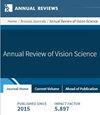视网膜神经节细胞的特征检测。
IF 5
2区 医学
Q1 NEUROSCIENCES
引用次数: 20
摘要
视网膜回路将感光细胞的像素表示转换为神经节细胞的特征表示,神经节细胞的轴突将这些表示传递给大脑。功能、形态学和转录组学调查已经确定了40多种小鼠视网膜神经节细胞(RGC)类型。RGCs提取不同复杂度的特征;一些只是用信号表示亮度的局部差异(即亮度对比度),而另一些则检测特定的运动轨迹。为了理解视网膜,我们需要知道视网膜回路是如何产生不同的RGC特征表示的。RGC特征集的目录反过来又是理解大脑视觉处理的基础。顺行追踪表明RGCs支配小鼠大脑中50多个区域。目前将RGC类型与大脑区域连接起来的地图还很初级,我们对视网膜信号如何在下游转化以指导行为的理解也是如此。在这篇文章中,我回顾了小鼠RGCs的特征选择性,它们是如何产生的,以及它们是如何在下游利用的。了解RGC信号的行为目的不仅对理解视网膜对视觉的贡献至关重要;它还可以引导我们找到视觉特征空间中最相关的区域。《视觉科学年度评论》第8卷预计最终在线出版日期为2022年9月。请参阅http://www.annualreviews.org/page/journal/pubdates用于修订估算。本文章由计算机程序翻译,如有差异,请以英文原文为准。
Feature Detection by Retinal Ganglion Cells.
Retinal circuits transform the pixel representation of photoreceptors into the feature representations of ganglion cells, whose axons transmit these representations to the brain. Functional, morphological, and transcriptomic surveys have identified more than 40 retinal ganglion cell (RGC) types in mice. RGCs extract features of varying complexity; some simply signal local differences in brightness (i.e., luminance contrast), whereas others detect specific motion trajectories. To understand the retina, we need to know how retinal circuits give rise to the diverse RGC feature representations. A catalog of the RGC feature set, in turn, is fundamental to understanding visual processing in the brain. Anterograde tracing indicates that RGCs innervate more than 50 areas in the mouse brain. Current maps connecting RGC types to brain areas are rudimentary, as is our understanding of how retinal signals are transformed downstream to guide behavior. In this article, I review the feature selectivities of mouse RGCs, how they arise, and how they are utilized downstream. Not only is knowledge of the behavioral purpose of RGC signals critical for understanding the retinal contributions to vision; it can also guide us to the most relevant areas of visual feature space. Expected final online publication date for the Annual Review of Vision Science, Volume 8 is September 2022. Please see http://www.annualreviews.org/page/journal/pubdates for revised estimates.
求助全文
通过发布文献求助,成功后即可免费获取论文全文。
去求助
来源期刊

Annual Review of Vision Science
Medicine-Ophthalmology
CiteScore
11.10
自引率
1.70%
发文量
19
期刊介绍:
The Annual Review of Vision Science reviews progress in the visual sciences, a cross-cutting set of disciplines which intersect psychology, neuroscience, computer science, cell biology and genetics, and clinical medicine. The journal covers a broad range of topics and techniques, including optics, retina, central visual processing, visual perception, eye movements, visual development, vision models, computer vision, and the mechanisms of visual disease, dysfunction, and sight restoration. The study of vision is central to progress in many areas of science, and this new journal will explore and expose the connections that link it to biology, behavior, computation, engineering, and medicine.
 求助内容:
求助内容: 应助结果提醒方式:
应助结果提醒方式:


